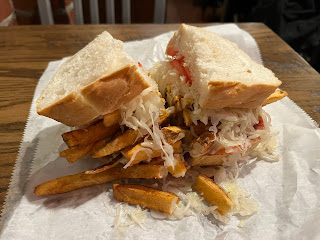 |
| Fort Wayne Railroad Bridge, constructed in 1904. |
Prior to a mid-January hockey game, I took a short walk on the trail to get some exercise and a have a late afternoon pregame meal. Accessing the trail at the Convention Center, I walked northeast on the southside of the Allegheny River. Hearing the calls of Canada geese, I looked over the railing and was surprised to see a cooper’s hawk flying out from underneath the Veterans Memorial Bridge, it did not make a sound, but for the flapping of its wing. Both the hawk and I were startled by each other’s presence. It was less entranced than I was about the encounter and preformed a tight turn and made for the other side of the river.
The trail, especially in the summer, is a haven for
homeless people. As I walk in January, there are many signs of a homeless
population, abandoned clothes and tents, but no immediate signs of habitation
along the trail. Perhaps efforts to
house people in during the winter months have been effective, but given the
situation of many, and the endemic problems associated with homelessness,
people with nowhere else to go will return to the banks of the rivers soon.
 |
| Peace and Love from "Justa Trash Panda" |
A walk through any neighborhood of Pittsburgh is a reminder of the past, this is especially true of the area known as the Strip District. Its name is derived from a geographical feature that is hard to discern with steel and concrete features distracting us. The “strip” refers to the narrow piece of land, about half a mile long, that lies between the river and the steep incline of the hills that define the city. Beginning in the late nineteenth century, many manufacturers and wholesalers opened businesses in the Strip. The trainyards that once stood here was a destination for fresh fruits and vegetables. The condiment company Heinz, famous for ketchup and fifty-seven varieties of sauces, would procure supplies along with other vendors here. Most wholesalers have left, but some remain, and it is a fun place to shop and wander, especially on the weekends.
A sandwich shop that is quintessentially Pittsburgh,
becoming synonymous with the city, had its beginnings in the neighborhood.
People from the Pittsburgh area maintain a strong bond with the city, even if
it has been decades since they have lived there. The sports teams help to
maintain that bond. Primanti Brothers, founded 1933 in the Strip District, provides
a culinary link to the city as well. The story goes that drivers would drop off
their trucks to be loaded at nearby warehouses and order a sandwich to go from
Primanti’s. By the time the sandwich would be ready, the truck should be
loaded, and the driver could start off. For the novice, fries and coleslaw are
included with meat and cheese as part of a huge sandwich. I know many people
who have had a quizzical look on their face with the idea that two side items
should be captured between two slices of Italian bread. The reasoning makes
sense: A driver could eat the sandwich while driving as part of an entire meal.
The need for handheld food for manual laborers is not uncommon. I am reminded
of the immigrant miners of the Upper Peninsula of Michigan, usually from
Cornwall, who had pasties, a pie comprised of meat and vegetables, to work each
day.
 |
| Primanti Brothers on 18th Street |
I chose a seat in the original sandwich shop in the far corner, where I would be watched over by Satchel Paige, Geno Malkin, Marc Andre Fleury, and the Stanley Cup. While some of the other Primanti’s locations are more upscale, this location on 18th street, has a feel of authenticity. The neighborhood in the winter feels gritty, the steel mills and warehouses, and the people who worked in them might be gone, but the remaining businesses have an entrepreneurial and defiant spirit; the ties to the community remain. Rather than laborers, the restaurant on a late January afternoon is full of visitors and sports fan. The table next to me was engaged in a multigenerational discussion of baseball, with an occasional hockey reference thrown in. I spot at least a couple of people who are Vancouver fans, the team the Penguins would play that night.
 |
| St. Stanislaus Kostka Church (1891) – Located at 21st Street and Smallman, speaks to the influx of immigrants into Pittsburgh in the late nineteenth century. |
 |
| Philosophy and argumentation via graffiti |
 |
| Capicola and cheese from Primanti Brothers |
No comments:
Post a Comment